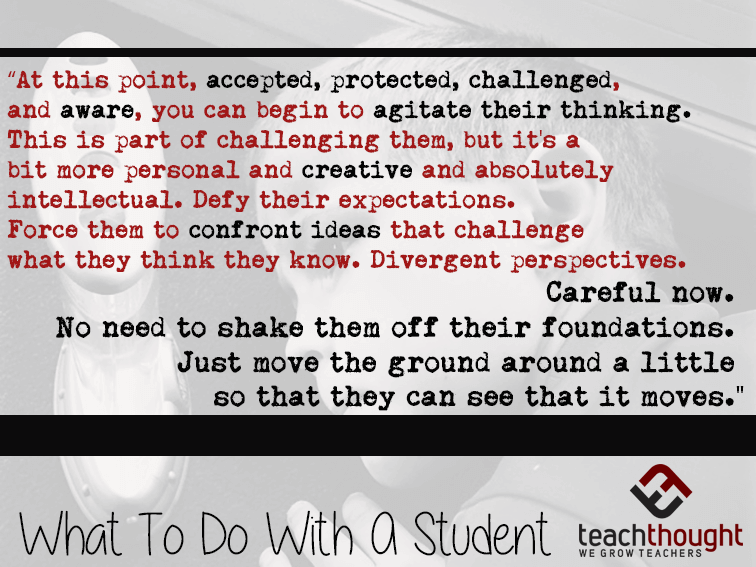
by Terry Heick
Say you’ve got some students.
Two or 122. Doesn’t matter–they’re there. What should you do with them? Oh, lots. There is a lot to consider.
First, you have to see them. Really see them for who they are, where they are. Not as test results, pending adults, nor as vessels for filling, or humanoids to push towards some goal they may not understand in either theory or application. You can’t see them in terms of gender, grade level, intelligence, compliance–you have to see that student. Who ‘are’ they? Where are they ‘from’? What do they think about themselves? About other people? About their own potential and their future? What motivates them? What do they–more than anything else–want?
Then you accept them. Accept everything without judgment because it has nothing to do with you, and probably less to do with them that you’d think. In your mind you now, to whatever level you are able considering all of your responsibilities as a teacher, have at least started to both see a child as they really are, and then have moved to accept all of that. The child and their story–everything that brought them to you in this place during this time in their life. You can pick and choose what to focus on with that child–what to teach them. That part comes later. For now, you simply really see and truly accept.
Next, you protect them. From bad policy. From bullies. From themselves. From bad assignments and useless academic standards and their own insecurities. That doesn’t mean you don’t let them fail. You do. But part of helping a student fail is protecting them from the kinds of delusions–again, about themselves and what they expect out of the world and people around them. If they feel seen and accepted and protected, they can begin to do their best thinking.
So you challenge them. That student and that level–what sort of challenge do they need? What suits them best? Is it against other students? A high score? Something creative? Something emotional? Musical? Personal? Academic? Short-term? Long-term? Public? Private?
With this kind of opportunity, you give them an opportunity to surprise themselves. Achievements should be varied and fresh and new. Something they haven’t done before, or a level of performance that haven’t achieved–and that they can see the value in. Remember, if you know that child in that place, then you have an idea of what they might see value in. You’ve set them up to achieve something–and here you are, beside them.
Then help them see and prioritize opportunities. Could be problems to solve. An opportunity for artistic expression. Inspiration. Collaboration with someone from another country. A chance to demonstrate empathy, curiosity, affection, or citizenship. You can start by pointing these opportunities out so they know what they’re looking for, and then help them spot them for themselves. When they can readily identify opportunities that matter to them–that child in that place–then they can prioritize them. They see their own time and creativity and ingenuity and attention as something value, which means it can be put to good use, or wasted. Like any other crucial resource, their attention matters–and is finite.
Part of this depends on the ability to ask the right question at the right time, so model curiosity for that student. This is what it looks like to wonder. To not be sure–to pause and consider in a situation what is and is not known, and responding accordingly based on context. Here and now, this is what’s happening, this is what’s possible, and this is how I choose to respond. Heavy stuff for anyone, much less a child.
At this point, accepted, protected, challenged, and aware, you can begin to agitate their thinking. This is part of challenging them, but it’s a bit more personal and creative and absolutely intellectual. Defy their expectations. Force them to confront ideas that challenge what they think they know. Divergent perspectives. Careful now. No need to shake them off their foundations. Just move the ground around a little so that they can see that it moves.
After that–and you’ve done a lot–finally help them to see themselves. Who they are and where they are–remember, this is where you started yourself. This is less about image and more about membership and legacy and community and identity. This will help them see their own interdependence.
I am a person.
I am a member of this family and this community.
I am connected to these people and this history and these legacies and these problems and these opportunities.
Therefore, I need to have these skills and understand these ideas so that I can respond, moment by moment, day by day, as I make a life.
Do these kinds of things–and so many others–with your students. These create authentic needs to know for all of the academic content you’ll teach them. But more crucially, you can be sure you’re not simply teaching content, or even ideas, but people.
What To Do With A Student




